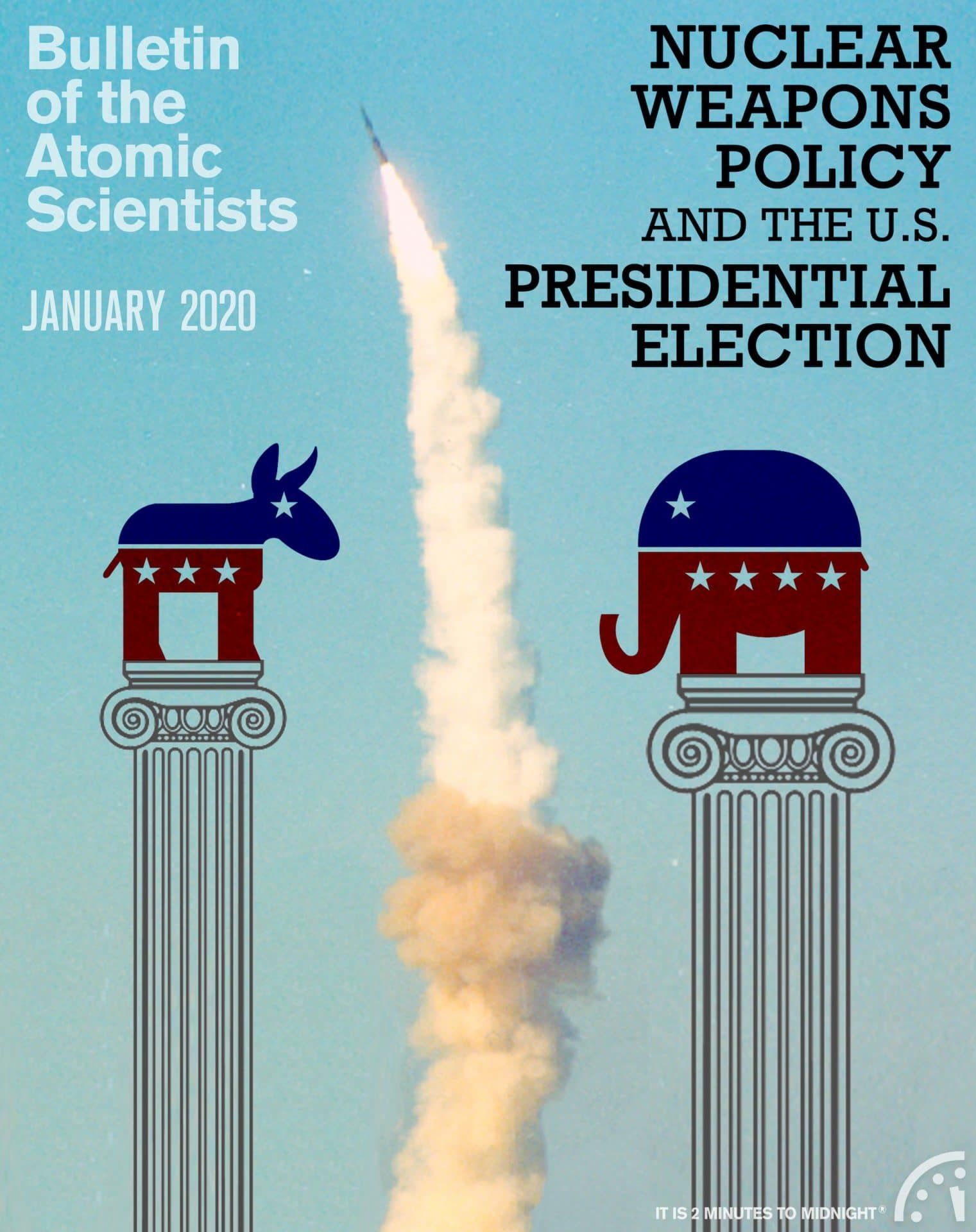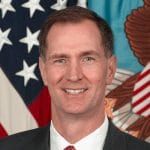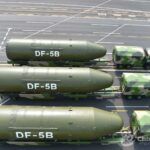Loose cannons: The president and US nuclear posture
By Bruce G. Blair | January 1, 2020
Loose cannons: The president and US nuclear posture
By Bruce G. Blair | January 1, 2020
During the last Arab-Israel war, my crewmate and I were sitting on alert in an underground launch center in Montana when, around midnight, we received an emergency message from the Pentagon. It ordered us to get prepared to fire the dozens of nuclear-tipped Minuteman missiles under our direct control. With a rush of adrenalin, we opened our safe and retrieved the launch keys and the codes needed to authenticate a launch order, and strapped into our chairs to brace for blast waves produced by incoming Soviet nuclear warheads. Then we waited, expectantly, for the order to fire. Hundreds of hours in launch simulators had conditioned us to expect that such an order would be inexorable and that ensuing escalation would culminate in a full-scale nuclear exchange.
For a fleeting moment, I wondered where President Richard Nixon’s head was at this time of nuclear tension with the Soviet Union and domestic political turmoil over the Watergate scandal. No one in our bunker had any inkling that he actually had retired earlier in the night “under the influence” and was oblivious to his underlings’ midnight decision to flex American nuclear muscles by ordering US nuclear forces to their highest level of alert since the Cuban Missile Crisis. While Nixon slept, a group of US security officials seized the reins of nuclear command and quietly ordered a worldwide military alert, readying thousands of nuclear weapons, including the 50 under our control in Montana, for immediate firing.[1] We also knew nothing about a previous intervention by Defense Secretary James Schlesinger instructing the Pentagon to contact him or Secretary of State Henry Kissinger before carrying out any nuclear orders given out of the blue by the politically besieged president.
Upon reflection these “deep state” shenanigans raise questions about the integrity of US nuclear command. Who was really in charge? Who is today? According to the US Constitution, Congress declares war and the president as commander in chief directs the war campaign. Although the division of responsibility seems clear, the prevailing view of experts is that the president possesses sole, veto-proof launch authority and can exercise it anytime without a congressional declaration of war. The US nuclear command, control, and communications system embodies this understanding.
Might an impulsive, incompetent or demented president attempt to order the use of nuclear weapons without apparent or sufficient cause? It is not beyond imagination. Might the attempt succeed? Definitely, especially if the aimpoint is an acknowledged adversary such as Russia, China or North Korea, and the president orders execution of a pre-existing strike option. The nuclear command system was designed to speedily enable, not block, such use.
The nuclear chain of command runs from the president through a national military “processing center” (normally, the Pentagon “war room”), which formats a launch order replete with authentication and unlock codes and transmits it directly to the executing commanders of the delivery platforms—nuclear-armed submarines, bombers, and land-based missiles – and simultaneously to all other nuclear command posts such as Strategic Command headquarters. Senior military and civilian officials such as the secretary of defense may or may not be consulted prior to a presidential decision.[2] Regardless, they have no formal role in authorizing or confirming an order to employ nuclear weapons. Nor are they are well positioned or equipped to improvise extra-legal measures that might thwart an arbitrary, capricious, or misguided launch directive. The execution of a pre-planned option using forces on launch-ready alert would take only a few minutes. Regardless of his/her state of mind, a president appears able to steamroll the nuclear forces into blindly following such an order, even a civilization-ending one.
Steamrolling the release of nuclear weapons can also work in the opposite direction, however. The president does not govern in a vacuum. He/she is entangled in a complex institutional and organizational web of operational procedures, constraints, and norms. When set in motion, the US nuclear posture with its strategy, plans and emergency war operations, which enable thousands of nuclear weapons on launch-ready alert to attack thousands of opposing forces in a coordinated fashion, has a “mind” and momentum of its own.
While a president cannot be overruled by anyone, creating opportunity for reckless belligerence, the US posture channels nuclear decision making toward the execution of pre-programmed contingency plans. During a confrontation, the president might become the steamrolled party.
The US nuclear posture is programmed for three basic wartime contingencies: After absorbing an enemy nuclear strike, it can execute a counterattack so devastating that it would deter an adversary from striking in the first place; after an enemy has begun launching its nuclear forces but before they reach their targets, the US system can execute what is known as “launch on warning,” requiring early detection of the enemy first strike, quick presidential decision making, and the rapid launch by individual commanders of deployed US nuclear forces; or the US command system can, before the enemy has fired its nuclear forces, initiate a preemptive first strike.
The president would discover that all of these contingencies are highly unstable in a crisis. “Second-strike” retaliation (“assured destruction” of economic and industrial infrastructure and/or counterforce strikes against opposing nuclear forces withheld from a first strike) leans precariously on a vulnerable command system. Launch on warning is infeasible and unsafe because of limitations in and questionable reliability of the command and early warning systems. “First use” of nuclear weapons in any realistic situation confronting an American president would not be rational and moral, and the fear of preemptive attack incited by this contingency is the textbook definition of crisis instability.
Although our nuclear posture prepares extensively for all these contingencies, I have difficulty imagining how any president could competently exercise nuclear authority in any of them. All of the contingencies work vigorously to erode restraint and stability in a crisis. A president would face a menu of bad choices so unsettling as to engender the erratic, impulsive, and aberrant behavior that the command system was not designed to suppress.
Some ameliorative steps could help stabilize a crisis and provide at least a semblance of a check on unwarranted presidential commands to use nuclear weapons. For the foreseeable future, however, the rational direction of nuclear forces promises to be the first casualty of a volatile nuclear confrontation. And the only completely satisfactory, permanent solution to the maelstrom of bad choices that US leaders would face during a nuclear crisis is to completely eliminate nuclear weapons.
The Achilles heel of “second strike”: Command, control, and communications vulnerability
During the eternal night in 1973 spent clutching our launch keys and codes, my crewmate and I entertained the worst case: a sudden massive Soviet nuclear assault. We understood that deterrence is not a physical firewall but a state of mind; malice, miscalculation, or mistake could shred it in an instant. The Soviets might well be going on high alert (they were) and preparing an attack. We buttoned up our launch capsule to boost its resistance to blast overpressure and reviewed instructions for generating oxygen using hand-cranked canisters. Procedures for digging to the radioactive surface in the aftermath of an exchange ran through our minds. We prepared mentally for riding out an attack.
Waiting, enduring assault, and hitting back hard was in fact the crux of US declaratory nuclear doctrine and the textbook essence of deterrence. US nuclear strategy required the ability to inflict severe and debilitating pain in retaliation to nuclear aggression against the United States or our allies. Missileer indoctrination emphasized the mission of “assured destruction” (city-busting) as the central purpose of our weapons. We were shown graphic pictures of the “walking dead” and indiscriminate devastation wrought by the atomic bombs dropped on Japan. At the end of our training, the instructors claimed our willingness to “turn keys” to fire our weapons was crucial to deterrence. We signed documents professing our unreserved willingness to carry out the unthinkable.
A typical missileer assigned to combat duty for several years conducts mock nuclear launches hundreds of times. Training and exercises usually feature a sort of mutual annihilation on the installment plan. Retaliation often begins with large-scale strikes— initially against opposing nuclear forces (75 percent of the Soviet target base during the Cold War, down to 54 percent today). The mock war pauses for armistice negotiations, and then inevitably the violence resumes. New orders are received, authenticated, and followed. The conflict escalates in phases over a simulated two-day period. Urban-industrial and leadership targets receive the brunt of the last waves. No target is spared. Casualties run into the tens of millions. Most are non-combatant civilians. US nuclear leaders may invoke the Article 51 “self-defense” clause of the United Nations charter to justify responding with nuclear weapons to nuclear aggression, but they throw the laws of war and all humanitarian considerations out the window during war games.[3] These games drive home the horror of massive and unacceptable devastation, rationalized as necessary to deter an enemy from attacking in the first place.
For an altogether pedestrian reason, this basic contingency seemed unrealistic to us, and to the rest of the chain of command. The war games always pretended the command, control, and communications system would not fail during nuclear conflict. We knew better. Despite being buried six stories underground and hung from giant shock absorbers, our launch capsule and all four backup capsules in our 50-missile squadron were vulnerable to blast waves from exploding Soviet warheads. The communications linking surviving capsules to high-level command posts were tenuous and likely to be severed. The high-level posts themselves in most cases stood little chance of withstanding assault.
Riding out an attack risked everything. If the Soviets struck the first blow, it seemed unlikely to me that the president or others in the legal chain of civilian succession would survive and manage to disseminate an order to retaliate, much less the series of orders simulated in war games. Only the Strategic Air Command’s airborne command post on airborne alert stood a decent chance of weathering a nuclear storm. With a flag officer (a brigadier or higher-ranking general) onboard, this rotating fleet of aircraft, code-named “Looking Glass,” orbited the American heartland around the clock. It provided the critical linchpin for commanding a retaliatory strike. Other “doomsday” aircraft such as the president’s “Nightwatch” militarized 747 stood alert on the ground where they were (and still are) vulnerable to sudden destruction.
But Looking Glass offered no assurance of command survival and successful propagation of the “go code” to far-flung strategic forces. Its most reliable communications were short-range, and its long-range transmissions were subject to massive signal disruption in a nuclear environment. Critical equipment was also unreliable. For example, a vital 3-mile long trailing-wire transmitting antenna was prone to jam up when unspooling out the back of the plane.
What was worse, Looking Glass had only minutes to hours of longevity in a nuclear environment. While serving a stint as a support officer for it, I was dismayed to learn about recent scientific studies of the adverse effects of a little-understood phenomenon known as electromagnetic pulse generated by nuclear explosions. Analyses predicted that the airplane’s avionics would be fried by the pulses, causing the pilot to lose the ability to steer the plane within minutes after exposure. Our unit was nearly panic stricken over this newfound vulnerability.
The harsh truth was that the United States lacked a survivable command system and could not meet an essential requirement of nuclear deterrence. Command, control, and communications were vulnerable to even a relatively small “surgical” strike —a few dozens of enemy warheads judiciously aimed at critical command and communications nodes. This Achilles heel put nuclear second-strike operations and deterrence in serious jeopardy, at best. Any notion of fighting a nuclear conflict, dominating escalation, and emerging the victor appeared far fetched. Many insiders lost confidence in the US ability to retaliate at all (Blair 1985).
Fundamental doubt persists to this day. The aging US nuclear command, control, and communication system remains a patchwork of cobbled subsystems. The Pentagon has stinted on its modernization for decades while pouring resources into nuclear and conventional arms and other weapons programs.
While some vulnerabilities have been partially remediated—such as protecting the avionics of command aircraft from energy surges—others persist or grow worse. Emerging technologies pose myriad threats to US wartime leadership, continuity of government, and the network’s overall functionality. Advances in anti-satellite warfare put critical communications, early warning, and navigation satellites increasingly at risk. Stealthy and maneuverable attack vehicles such as nuclear-tipped cruise missiles on Russian submarines prowling off of the US coast pose a growing potential threat of sudden decapitation. So will hypersonic vehicles in the future. And cyberattack capabilities increasingly threaten the reliability of the computer-driven command, control, communications, and early warning network.
While the sea-based backbone of the US strategic forces can endure for days, weeks, or months, this network would likely collapse within minutes or at most hours—and fail to reconstitute after an enemy first strike. This fault line in the edifice of deterrence based on second-strike retaliation is a potential source of acute crisis instability. At the brink of conflict, US leaders fearing imminent hostilities and a possible decapitating first strike would likely recoil from the notion of riding out an attack, and Russian leaders could be tempted to exploit US command vulnerabilities and strike first.
Mal-adaptations: pre-delegation and launch on warning
The United States adapted to the specter of command paralysis in two risky and disturbing ways. First, every Cold-War president from Eisenhower to Reagan pre-delegated their nuclear launch authority to a raft of senior military leaders, who in turn sub-delegated it to mid-level admirals and generals (generally of two-star rank, meaning they were normally in command of Air Force and Navy Fleets). These included the senior officer onboard Looking Glass. (Kennedy did not give explicit new pre-delegation instructions but he deliberately did not revoke his predecessor’s instructions.) These arrangements covered situations involving communications outages or incapacitation of top US leaders, coupled with confirmed nuclear strikes by an identified enemy against US or allied territory or forces. If the conditions were met, senior strategic commanders inherited virtually carte blanche authority. An officer to whom I directly reported and who later became the deputy commander of the Strategic Air Command during the Reagan administration told me (after his retirement) that his discretionary authority would have allowed him to order an all-out strategic nuclear attack.
While reducing the risk of decapitation and relieving some of the pressure to launch on warning before the arrival of enemy warheads, pre-delegation created other risks. Since release authority devolved quickly, the president’s grip on US nuclear forces might slip into the hands of military commanders in the fog of conflict and produce a launch that was not intended by the president, even though it might have been sanctioned by prior guidance. Moreover, all the authorization and unlock codes needed to issue valid and enabling launch orders resided throughout the military, raising the possibility of an outright unauthorized launch. (Contrary to popular belief, the president does not possess the actual launch authorization codes, known as the Sealed Authenticator System. These have always resided strictly in military hands.) Missile launch officers like myself would not know whether our orders were truly sanctioned by the president or came from an unauthorized source.
President Bill Clinton and then Defense Secretary William Perry quietly rolled back pre-delegation in the early post-Cold War years (approximately 1993) although they did not retrieve and consolidate the distributed codes in military custody.[4] As tensions with Russia rise and command, control, and communications vulnerability becomes salient again, the question of reinstituting pre-delegation may well be revisited. The question of whether to delegate would almost certainly be raised during the emergency launch protocol if the president opts to ride out an attack.
The second notable adaptation to command vulnerability was the creation in the 1960s of a presidential launch protocol to expedite decision making and facilitate launch on warning in the face of the era’s game-changing new technology: Soviet intercontinental ballistic missiles armed with megaton-caliber warheads.
US planners sought to end-run a quickly emerging threat to the US command system (and soon to silo-based missiles as well) by compressing early warning, attack assessment, decision making, and force execution into the 15-30 minute period between the launch and arrival of enemy nuclear warheads. This protocol required a streamlined drill-like process carried out during the 30-minute flight time of incoming weapons delivered by intercontinental missiles flying from one side of the planet to the other, or the 10- to15-minute flight for sea-based ballistic missiles lofted from submarines patrolling in the oceans. US strategic forces had to be poised for immediate launch at the direction of higher authority, and the president had to be ready to decide whether and how to respond to indications of incoming warheads within a few minutes after being notified. This protocol, built for speed and assertive presidential leadership, offered no margin whatsoever for building guardrails meant to impose checks and balances on his authority.
As the contemporary timeline below makes clear, the sequence of events and actions from the early warning hubs to the apex of command and down to individual executing commanders must be orchestrated with lightning speed with no margin for human or technical error, which means relying almost entirely on preprogrammed operations and checklists. The timeline assumes a Russian intercontinental ballistic missile (ICBM) launch only. If sea-based Russian ballistic missiles break water from typical patrol areas (west of Bermuda during the Cold War), the flight time would be halved, and the US decision process would be further compressed. If sea-based cruise missiles take flight from US coastal waters, there might be no warning at all before the first nuclear warheads incinerate Washington, D.C.
Launch on warning was not feasible under this protocol until the early 1970s, when the United States began deploying early warning satellites capable of detecting the hot plumes of missiles launched anywhere in the Soviet Union and China within a minute after lift off. (The Soviets matched this capability in the early 1980s.)[5] My crewmate and I practiced launch on warning so often that we could perform the procedures by heart, reflexively launching scores of missiles within one to two minutes after receiving the order.
Launch on warning is the antithesis of a deliberative process. It involves enacting by rote a prepared script that permits scant human deliberation or judgment. This applies to every level of the chain of command, including the Pentagon and Strategic Command war rooms, which have one minute to brief the president, who has roughly six minutes to decide whether and how to respond. Launch on warning turns humans into virtual automatons. Human reasoning is reduced to decision heuristics.
But despite being driven by checklists, launch on warning still involves a tricky interplay of human and technical parts that must mesh smoothly and perform without error under impossibly short deadlines. Small mistakes can be disastrous, and not just at the apex of command. The entry of a single wrong digit by a launch crew could switch war plans and spell the difference between striking remote missiles in Siberia and destroying Moscow and other cities.
At the presidential level, launch on warning invites hasty miscalculation under the most pressurized circumstances imaginable. President Reagan was appalled by the time pressure. (He said he had six minutes to decide.) President George W. Bush complained he could not even get off the “crapper” in time to authorize launch on warning. President Obama thought it was crazy to compel a president to decide so hastily whether to launch a counter-attack—and what the size and nature of the counter-attack should look like— based on incomplete information about a Russian attack.
Nevertheless, the military historically has been adamant that launch on warning is essential if the alternative means riding out an attack. The latter was, to US military leaders, anathema. As Gen. Lee Butler, a former head of the strategic forces, stated, “Our policy was premised on being able to accept the first wave of attacks…. Yet at the operational level it was never accepted…. They built a construct that powerfully biased the president’s decision process toward launch before the arrival of the first enemy warhead … a move in practice to a system structured to drive the president invariably toward a decision to launch under attack” (Schell 1998: 191-194). In exercises, stand-ins for the president still complain today that the launch-on-warning machinery “jams” them into making the fateful decision prematurely on the basis of inadequate information.[6]
The concern is not just that a president would be driven to order a launch on the basis of false information, but that a rushed decision would result in an ill-conceived response that triggers the launch of whatever Russia held in reserve, including deliberate attacks on American cities. President Jimmy Carter once personally participated in an exercise in which he reacted angrily to a limited Soviet strike by ordering a massive and disproportionate counterattack that all but guaranteed an all-out assault by withheld Soviet missiles, according to a former 3-star general who stood next to Carter at the time.[7] A judicious, delayed launch, rather than a hasty prompt launch, could have a better chance of de-escalating a conflict and limiting the carnage inflicted upon the American people.
The risks of accidental nuclear war or an injudicious prompt launch that escalates to full-scale nuclear exchange are so obvious and unnerving that the Pentagon went to great lengths during the Cold War to keep the American public in the dark about US plans to launch on warning.[8] It buried under layers of secrecy the deep misgivings of presidents and other senior officials, the numerous false alarms of enemy attack experienced (on both sides), and the panic and confusion that ensued within the command and control and early warning hubs during these incidents. (Early warning crews cancelled the alarms after eight minutes in the two scariest episodes, a delay over the requisite three minutes designated in the launch on warning protocol that was deemed so egregious it got them fired on the spot.)
Cyber warfare is compounding these risks. Cyber penetration of early warning networks could corrupt the data on which a presidential launch decision would depend. Farther down the chain of command, cyberattack could degrade the launch-readiness of strategic forces, especially the silo-based Minuteman missiles. It appears far more remote but not impossible that cyberattack could even produce unauthorized launches of these un-recallable missiles, which are poised to fire instantly or with a short pre-programmed time delay after receiving a short stream of computer code. The missiles do not care who sends them the code, only that it is correct.
The disconcerting truth is that US officials cannot guarantee that US early warning and launch circuitry is bug free. The requirement for bug-free nuclear command, control, and communications is officially waived in order to provide the president with prompt launch options. Meanwhile, the malware danger worsens daily as the supply chain for critical electronic components, many acquired from Asian sources, eludes effective oversight and safeguards.
Existing and emerging threats are further undermining the feasibility of launch on warning. The short flight time of ballistic missiles and stealthy cruise missiles fired from Russian submarines patrolling off the US coasts would reduce warning and decision time to so few minutes as to foreclose a launch-on-warning option. Cruise missiles would likely elude detection throughout their flight to targets on the East Coast. The first warning of attack could well be a nuclear detonation that neutralizes the top layer of US civilian and military command.
Emerging threats include the recent widespread deployment of maneuverable ballistic and hypersonic missiles and warheads whose targets cannot be predicted. Russia, China, and North Korea are incorporating new technology into their ballistic missile and reentry vehicle designs to allow for directional changes during boost, mid-flight, and reentry. This development has resulted in missile launches with confusing flight patterns and unpredictable impact points. On several such occasions Presidents George W. Bush and Barack Obama were notified of ambiguous threats in real time. (This never happened during the Cold War.)
Despite the diminishing feasibility of launch on warning, this “option” remains in play today. The 2013 presidential nuclear employment guidance—still in force today—requires the Pentagon to reduce reliance on launch on warning but to keep it available to the president. A recent report by the Pentagon’s in-house “think tank” finds virtue in the risk that a US president rushing to make a decision in minutes might well order an injudicious escalatory response that ends in a full-scale nuclear exchange (Chambers etal 2019). What virtue? It supposedly complicates Russia’s calculus of the effectiveness of its first strike and reduces Russia’s confidence in being able to “favorably manage escalation” and “convince US leaders to back down.” Launch on warning may be a cosmic mistake waiting to happen, but the report’s authors believe the risk works to US advantage.
From my perspective, in terms of deterring an adversary, prompt launch is no substitute for having secure command, control, communications and strategic forces for a second strike. The operational liabilities of a launch-on-warning posture far outweigh any hypothetical contribution to making the Russians think twice before attacking. Launch on warning simply is not a viable, stable, or safe contingency. It is unacceptably dangerous at the brink of nuclear conflict, when leaders are anticipating an imminent enemy strike and are predisposed to believe the alarm bells warning that one is under way. And it throws caution to the wind by pressuring the president to decide within minutes how to respond to an actual attack. Launch on warning risks launching on false warning or retaliating on true warning in a possibly disproportionate or injudicious manner that provokes an unconstrained nuclear exchange. It is small consolation that these dangers scare others as well as ourselves.
An unstable default contingency: US first use
First use of nuclear weapons, the third contingency, is even less stable than the other two, but planners cling to it because of its relative feasibility and its putative advantages in the arena of warfighting.[9] The US nuclear posture has always programmed first-use options, including large-scale preemptive strikes against Russian and Chinese nuclear forces. (Preemptive strike designations historically would have appeared in a launch order.) Smaller-scale first-use (and second-use) options first appeared in the mid-1970s under the rubric of “limited attacks options.” The latest variant is noted in the Trump administration’s nuclear posture review; it calls for “low”-yield weapons deployed on US strategic submarines for use—first or second—in small numbers in the early phase of a conflict.
The reasoning behind the proliferation of smaller strike packages has several elements. First, a plethora of options that includes first-use increases US flexibility and throws adversaries off balance by keeping them guessing about US strategy and tactics. Also, many planners believe that nuclear weapons may be needed to counter a widening array of conventional, biological/chemical, and cyber threats. During the Cold War, US nuclear weapons would have been employed early to blunt a Soviet-led Warsaw Pact conventional invasion of Western Europe. The role of nuclear weapons in countering non-nuclear threats steadily expanded after the Cold War’s end, beginning with the Nuclear Posture Review conducted in the Clinton administration, which linked nuclear weapons to efforts at countering biological threats. Today some planners envision a first-use role for US nuclear weapons in responding to cyber attack. The Nuclear Posture Review of the Trump administration does not rule out the possibility that a catastrophic cyberattack against critical Western civilian infrastructure would be met with a US nuclear response.
From the standpoint of military expediency, there’s an obvious upside to the first-use contingency: With nuclear weapons, going first is far easier to execute than going second. US nuclear forces and command, control, and communications would be intact (though they may suffer considerable damage if a conventional conflict precedes the nuclear strike) and highly capable of coordinating an offensive strike that could confer a decisive warfighting edge. By the same token, a first strike could minimize an adversary’s potential retribution, limit damage to the US homeland, and position the United States to dominate escalation and thereby terminate war on terms favorable to U.S. interests.
But the brief for first use omits myriad downsides. A rational and moral leader would balk at crossing the nuclear Rubicon unless four conditions were satisfied: The threat requiring a nuclear strike rests on ironclad, unassailable intelligence; only nuclear weapons can carry out a successful mission against the threat; predicted civilian casualties would not be so large as to violate humanitarian law and would be otherwise acceptable[10]; and a nuclear strike against a nuclear-armed adversary would not risk escalating to large-scale nuclear conflict and devastation of cataclysmic proportions.
In reality, it is improbable that all these conditions would be simultaneously met. That none would be met is quite possible. History shows repeatedly that intelligence is fallible and often very wrong. (The Iraq WMD threat assessment is Exhibit A.) The need for nuclear firepower is undercut by the US conventional juggernaut; modern precision-guided conventional and cyber weapons can perform almost any mission as well as nuclear weapons, including the destruction of facilities as fortified as missile silos. As for civilian casualties, the carnage and radiation sickness could take a heavy toll depending on the number and types of targets and the yield of US nuclear weapons employed against them. And of course, the risk that first use on any scale would trigger catastrophic nuclear escalation cannot be dismissed.
Escalatory updrafts
The last point alone demolishes the warfighters’ case for a US first use of nuclear weapons against Russia or China, and perhaps even North Korea. The nuclear command system is woefully inadequate for controlling escalation in the way warfighters envision. Their game plan is to seek bargaining leverage over an adversary—to persuade it that it has more to lose than gain—by raising the ante during a nuclear conflict. This is the essence of the nuclear warfighter’s strategy of “escalation dominance” and “deterrence by denial.” It is the subject of prolific arm-chair speculation about climbing the “ladder of escalation” and successfully coercing an enemy to throw in the towel. As discussed earlier, I played this game all the time in the missile procedures trainer. But the real world is not a simulation. The warfighters’ game plan ignores the fact that the US nuclear command system lacks the ability to manage such complex strategy in the midst of a nuclear conflict.
This inadequacy goes beyond deficiencies in infrastructure and information collection and processing. It extends to the human dimension. Presidents and their advisors cannot expect to control escalation if they do not even grasp the potential consequences of their own nuclear choices.[11] Although launch protocol involves a briefing and consultations with experienced nuclear advisors, these are “quick and dirty” exchanges lasting at most a few minutes; they may confuse or mislead. During the Cold War, a president who ordered a major nuclear strike that purportedly avoided Soviet cities would have been in for a big surprise. He would have discovered that all major Soviet cities had been obliterated due to ill-designed target plans. This is only a sample of the surprises to be encountered in pursuing the pipedreams of nuclear warfighters.[12]
The fog of nuclear conflict will prove all the thicker because leaders and planners lack adequate knowledge about their adversaries’ mindset, resolve, wartime aims, and game plans. For instance, de-classified Soviet documents show clearly that the US strategy of “escalation dominance” was completely out of sync with Soviet nuclear strategy and that escalation to full-scale nuclear war was virtually inevitable if the United States struck first.[13]
After many decades of scholarly research, it is still not known what leaders in Moscow and Beijing were thinking during Cold War crises involving US attempts to threaten nuclear violence to coerce them.[14] Today it would be foolhardy in the extreme to presume we would know Putin’s, Xi’s, and Kim’s minds and behavior in wartime.
A prudent leader would not only refrain from initiating the actual use of nuclear weapons because of the danger of escalation; that leader would also refrain from brandishing them at all during a confrontation. The fear of an adversary striking first is the leading textbook cause of crisis instability. To stabilize a military crisis situation, what is actually needed is predictability and reassurance that first use is not on the table.
For many strategists, however, taking options off the table looks like weakness. Retired Gen. James Mattis (the recent defense secretary) has a favorite military maxim: “Never tell the enemy what you are not going to do.” Strategists weaned on Thomas Schelling’s classic game theory arguments believe threatening, manipulating risk, and blackmailing are the currency of savvy crisis diplomacy. And it is certainly true that past US presidents have regularly played nuclear brinksmanship with the Soviets and Chinese and displayed incautious risk-taking in their crisis maneuvering. This was in fact the playbook of the Nixon advisors who ordered the world-wide nuclear alert that my crewmate and I helped implement in 1973. This alert sent a provocative message to the Soviets: The United States was prepared to play nuclear roulette to gets its way.[15]
Nuclear roulette begins at the outset of a crisis as the belligerents intensify their intelligence, surveillance, and reconnaissance operations. The aim is to maintain “situation awareness,” but the activities lend themselves to the worst-case interpretation that the adversary is updating its targeting in preparing to strike. Similarly, nuclear forces and command structures are programmed to go to higher readiness to prepare for war if the adversary will not back down.
Although the motives may be defensive, these activities may appear to be precursors of a first strike and provoke an action-reaction spiral that spins out of control. Certainly, if even a single nuclear weapon were used, the strategic nuclear forces on both sides would move rapidly to a maximum war footing and project credible mutual threats of large-scale preemptive attack. In sum, a nuclear posture gearing up for a possible enemy first strike risks becoming a self-fulfilling prophecy.
From the perspective of presidential decision making, the first-use contingency could easily accelerate escalation to the point of causing mental duress. This contingency is also notable for its absence of guardrails and the ease with which a misguided or rattled president could order it. The launch protocol described earlier for launch on warning applies equally to first use. Although the timeline could be extended greatly, the president could choose at any time to end the discussion and order a strike.
During the Cold War, I seldom practiced executing a first strike, and today there are no foreseeable scenarios that would justify transgressing the nuclear taboo of first use. Nevertheless, a first nuclear strike remains the default contingency of the US posture, owing to the huge uncertainties surrounding the alternatives—second-strike retaliation and launch on warning. A crisis that brings the belligerents to the brink of nuclear war would compel consideration of first use. Nuclear warfighters who reject the adage that a nuclear war cannot be won and must never be fought may well brief and tout the purported warfighting advantages of going first. Even though first use runs counter to and undermines of the entire framework of the global nuclear order, in which nuclear weapons exist only to deter, leaders may waver if it seems the least fraught choice at the moment of truth. An impulsive president may be drawn to it. Wiser advisors may counsel restraint, but nothing would stand in the way of the president ordering a first strike.
The likely if not inevitable consequence of attacking a nuclear adversary with nuclear weapons is nuclear retaliation and uncontrolled escalation that crosses the threshold of acceptable damage to this nation. First use runs an existential risk to the United States and the world. It carries a huge risk of triggering a nuclear exchange of cataclysmic proportions with massive casualties to all the belligerent parties and beyond.
Recommendations for reforming US command and control of nuclear weapons
Because of the inherent danger of first use of nuclear weapons, the US government should, first, terminate operational planning, training, and exercising for the contingency of striking first. Introducing nuclear weapons into conflict—indeed merely preparing for it—is a recipe for catastrophic escalation. Scuttling the first-use option would also remove the biggest opportunity for a disturbed president to trigger Armageddon with a single bad call.
To help enforce this policy change, the US Congress could legislatively restrict the first use of nuclear weapons. Professor Matthew Waxman, a top legal expert on this subject, says there are strong arguments that Congress has the constitutional power to do so.[16] Two pertinent bills are currently under consideration in Congress. The Warren-Smith bill states that it is the policy of the United States not to use nuclear weapons first.[17] The Markey-Lieu bill stipulates that any first use of nuclear weapons would require the approval of the US Congress.[18] If Congress passed such restrictions and the president signed them into the law without objection, the president would appear to become legally bound by the obligation and accountable for any transgression of it.[19] Alternatively, the president might issue a presidential “signing statement,” either objecting to the constitutionality of the provision or reserving the right to apply it only to the extent that it is consistent with the president’s constitutional prerogatives as commander in chief.[20] However, the president could issue such a statement but still commit to follow the law as a matter of executive branch policy (perhaps implemented by executive order).[21]
The commitment not to initiate the use of nuclear weapons could be further strengthened by negotiating no-first-use treaties between potential nuclear adversaries.[22] A ratified treaty would bind the United States as a matter of international law (in addition to the prospect of Congress taking action that binds the president as a matter of domestic law). As with domestic law, however, lawyers will debate whether such treaties are absolutely binding on a president’s authority to order the first use of nuclear weapons.[23]
Should the bills pending in Congress pass into law, they would cue the Pentagon to modify the US nuclear operational posture accordingly. One recommended change to the launch protocol would ensure that any unilateral first-use order from the president would not go through a “processing center” directly to the individual commanders of the strategic delivery platforms, as would happen today under current arrangements. Instead, a new policy would alter the functional chain of command, to run from the president to senior civilian officials (Secretary of Defense) and military officers (the chairman of the Joint Chiefs of Staff and the head of Strategic Command), their deputies, and their respective command posts, placing them in a position to intercept an illegitimate first-use order before it could reach the launch crews. Congress could facilitate such a change through legislation and by using the power of the purse to compel the executive branch to devise and implement a new launch protocol.
If Congress does not pass restrictions on the president’s first use authority and the executive branch does not adopt a no-first-use policy, I would still recommend changing the launch protocol. It is likely that US policy will continue for the foreseeable future to accept that a truly extraordinary situation may arise in which the first use of nuclear weapons is warranted. Again, I cannot envision such a situation. That said, I recommend a new process for making any such decision. Congress—represented by a group of senior legislators such as the Speaker of the House and the Senate pro tempore, who are next in line to succeed to the presidency after the Vice President, along with the chairs and ranking members of the four key defense and intelligence committees—would provide advice and consent. Time permitting, this proxy group would convene to review any proposed first use before voting to approve or not. In an emergency, the House speaker and Senate pro tempore could represent this rump group. Whenever the launch protocol is activated, these two individuals would be automatically added to the emergency conference that would include a dozen or so officials from the executive branch.
Assuming the congressional rump delegation sanctions the first use of nuclear weapons, in this new launch protocol the secretary of defense and the attorney general or their deputies would concur or demur. These members of the president’s cabinet would provide independent advice and consent on the utility and legality of employing these weapons. If the secretary confirms that such use serves the national security interest and the attorney general certifies an order is legal and in conformity with humanitarian law, the president’s order for a first strike could then be executed.[24]
A second recommendation would terminate operational planning, training, and exercising for launch on warning, which imposes a timeline in which rational deliberation and choice would be next to impossible. Adding a requirement that the defense secretary and other senior officials co-authorize a launch order does not solve the underlying problem of insufficient time and information. It is unclear to me how co-authorization or any other adjustments could meaningfully strengthen checks and balances while alleviating the danger of misinterpretation and miscalculation in the drill-like atmosphere of launch on warning.[25]
The feasibility of safely implementing launch on warning under realistic combat conditions, including cyber attack, is so much in doubt that it should be eliminated from the repertoire of the launch protocol. This step would in turn eliminate the rationale for keeping vulnerable, “use-or-lose” silo-based missiles on hair-trigger alert; they could instead be de-alerted or eliminated so that they no longer pressurize the decision process or invite hacking of their launch circuitry.
The purported warfighting advantage of launch on warning in complicating an adversary’s calculus of its first strike effectiveness pales in comparison with its disadvantages. Launch on warning runs large and inherent risks. It is a dysfunctional response to vulnerabilities in US nuclear command and force structures. It should not be a contingency on which to organize the US (or Russian) nuclear posture.[26]
Many useful defensive steps could be taken during the brief period of time now allotted to the launch-on-warning decision. The president, successors, and senior advisors could evacuate without delay, protecting against leadership decapitation. The entire nuclear command, control, and communications system could reorient from supporting a quick launch decision to collecting and processing information for re-thinking strategy and formulating a response that serves the US national interest after an enemy strike that shatters all prior beliefs, assumptions and plans.
My third recommendation involves the US nuclear command, control, and communications system itself, which must be revamped to provide the country with a secure second-strike capability. Survivable command and control and nuclear forces capable of inflicting unacceptable damage in response to nuclear aggression are essential stable deterrence. No one has advanced a better idea for discouraging pre-meditated nuclear aggression in an anarchic world. But the idea has been honored in the breach when it comes to nuclear command and control, which historically received very short shrift in the defense department’s budgetary sweepstakes.[27]
Building robust and survivable command, control, communications, and early warning systems should take absolute precedence over other defense programs. If these systems fail, nothing else matters. Investing nearly two trillion dollars in modernizing and maintaining US strategic bombers, submarines, and silo-based intercontinental missiles, as presently planned, will not advance this aim. On the contrary, massive investment in weapons will siphon funds from vital command and control programs.
US command system modernization will need to provide for comprehensive continuity of government and robust military communications. This is a daunting but feasible challenge that will have to tackle myriad emerging threats, ranging from cyberattack to anti-satellite warfare capabilities to stealthy, maneuverable vehicles capable of severely degrading and possibly decapitating the US command system. Fixing the system will require transformational approaches to: securing the supply chain for electronic components; deploying small “cheap” satellites in redundant numbers; building capacity to repopulate space and other domains with command and control satellites and other equipment and to reconstitute vital air and ground command and control units that have been attacked; and shifting from relying on short-endurance “doomsday” aircraft for last-gasp command, control, and communications to operating an enduring terrestrial and sea-based command system. That endurance should be commensurate with the ability of strategic submarines to remain on launch-ready patrol at sea for months after nuclear war begins.
The bill for these transformative innovations will be large. Annual spending on nuclear command, control, communications, and early warning will have to increase from $4 billion today to perhaps $8 billion or more, even if the United States pivots to a deterrence-only posture that halves the size of the US nuclear arsenal (Blair, Foley, and Sleight 2018).
A robust and enduring capability to respond to nuclear aggression would allow for real deliberation during conflict. The president’s nuclear authority would be preserved and any need for delegation of nuclear strike decisions obviated. Decision time could be extended to days, or weeks, or even longer, allowing for an informed damage assessment and formulation of a judicious response aligned with humanitarian law. Secure second-strike nuclear forces could be re-directed as necessary. A conventional-only response against certain classes of targets might be called for.
Enabling the president to intelligently determine a course of action does not mean that a warfighting strategy of escalation dominance can or should be pursued. The basic challenge is to build capacity to assure an appropriate response to nuclear aggression. This would buttress basic deterrence. Exquisite nuclear warfighting is the stuff of arm-chair strategists living in some parallel universe, not the real world.
From the standpoint of presidential authority, the challenge of this contingency is to ensure continuity of government by protecting the president and the legal chain of civilian succession and providing resilient means for them to direct nuclear forces to coherent national purpose. In the context of post-strike decision making, the issue of checks and balances on the president’s launch authority becomes a lower priority. The primary concerns are that unity of command be preserved under proper civilian authority and that unauthorized use is prevented.
An oft-heard official US mantra states that as long as nuclear weapons exist, they must be safe, secure, and reliable. That mantra is profoundly misleading. It implies that the existing nuclear arsenal indeed embodies these features. While this is largely true for the individual weapons in the US nuclear arsenal, the macro nuclear picture looks much different. The weapons are embedded in a nuclear operational posture that is not stable, safe, or reliable across the range of contingencies in which those weapons might be used.
As long as this state of affairs remains, nuclear weapons ought not to exist.
The only potentially stable contingency is second-strike retaliation to nuclear aggression. The US nuclear posture should be organized strictly around this contingency, supported by secure and reliable nuclear command and control and forces. This reorientation will require a new command, control, and communications architecture and heavy investment to build it. First use and launch on warning are dangerously unstable contingencies that should be removed from the repertoire of the US posture.
This is a stop-gap solution to a contemporaneous problem of strategic stability. Over the long term, worldwide elimination of nuclear weapons is the only foolproof answer to the myriad risks of their use.
Disclosure statement
No potential conflict of interest was reported by the authors.
Funding
This research received no specific grant from any funding agency in the public, commercial, or not-for-profit sectors.
Author information
Bruce G. Blair is a research scholar in the Program on Science and Global Security at Princeton University and is co-founder of the Global Zero movement for the elimination of nuclear weapons. From 2011 to 2017, he served as a member of the US Secretary of State’s International Security Advisory Board. For many years, Blair was a senior fellow in the Foreign Policy Studies Program at the Brookings Institution and served as a project director at the Congressional Office of Technology Assessment. He previously served in the US Air Force as a Minuteman ICBM launch control officer and as a support officer for the Airborne Command Post of the Strategic Air Command. Blair holds a doctorate in operations research from Yale University.
References
Betts RK (1987) Nuclear Blackmail and Nuclear Balance (Brookings), p. 19.
Blair BG (2014) “Mad Fiction,” Non-Proliferation Review, Vol 21: No. 2, p. 3.
Blair BG (1993) The Logic of Accidental Nuclear War (Brookings).
Blair BG (1985) Strategic Command and Control: Redefining the Nuclear Threat (Brookings).
Blair BG with Foley E-C and Sleight J (2018) The End of Nuclear Warfighting: Moving to a Deterrence-Only Posture, Global Zero; Program on Science and Global Security, Princeton University, September.
Chambers WA etal (2019) Presidential Decision Time Regarding Nuclear Weapons Employment: An Assessment and Options, Institute for Defense Analyses, June. Available at: https://www.globalzero.org/wp-content/uploads/2019/11/IDA-Nuclear-Employment-Decision-Time-Assessment.pdf
Dunlap CJ Jr (1997) “Taming Shiva: Applying International Law to Nuclear Operations,” The Air Force Law Review, Vol. 41: 163-165
Gray CS and Payne K (1980) “Victory is Possible,” Foreign Policy, No. 39 (Summer): 14-27.
Gronlund L, Wright D, and Fetter S (2018) “How to limit presidential authority to order the use of nuclear weapons,” Bulletin of the Atomic Scientists. Available at: https://thebulletin.org/how-limit-presidential-authority-order-use-nuclear-weapons11454.
Richard TT (2017) “Nuclear Weapons Targeting: Evolution of Law and US Policy,” Military Law Review, Vol. 224, No. 4: 862-978.
Sagan SD and Valentino BA (2017) “Revisiting Hiroshima in Iran: What Americans Really Think about Using Nuclear Weapons and Killing Noncombatants,” International Security 42:1 (Summer): 41–79, doi:10.1162/ISEC_a_00284.
.
Scheer R (1982) Robert Scherer interview with Charles Kupperman (current deputy national security advisor) in With Enough Shovels: Reagan, Bush, and Nuclear War (New York: Random House), 130-31.
Schell J (1998) The Gift of Time (New York: Metropolitan Book), pp. 191-194.
[1] This cabal was led by Henry Kissinger, Secretary of Defense James Schlesinger, White House Chief of Staff General Alexander Haig, and the Chairman of the Joint Chiefs of Staff. They ordered US forces to move to Defense Condition 3.
[2] Under the law that last reorganized the Department of Defense, the Goldwater-Nichols Act, the chain of command is stipulated to run from the president to the defense secretary and then to the combatant commanders, but this law contains a loophole. It says this is the chain of command unless the president directs otherwise, which presumably explains why the defense secretary is skipped over in the launch protocol. See
https://www.govinfo.gov/content/pkg/STATUTE-100/pdf/STATUTE-100-Pg992.pdf
[3] It takes herculean sleight of mind to reconcile the law of armed conflict with a US nuclear target plan that includes around 1,500 aimpoints, many hundreds located inside large cities in Russia and China. For attempts to reconcile them, see Dunlap (1997) and Richard (2017). For an official US attempt at reconciling the law of armed conflict with the use of nuclear weapons, see https://www.icj-cij.org/files/case-related/95/8700.pdf .
[4] I discovered this change after extensive conversations with many senior generals who served in top nuclear positions during the past 25 years. Perry confirmed this roll-back.
[5] For a detailed examination of the evolution of U.S. and Soviet launch on warning, see Blair (1993).
[6] See https://www.armscontrol.org/act/2018-01/features/strengthening-checks-presidential-nuclear-launch-authority.
[7] As told to me by Lt. Gen. (ret.) George Miller.
[8] Secretary of Defense Casper Weinberger confiscated my report on the subject, written for the Congressional Office of Technology Assessment in the mid-1980s, and defied a congressional demand to return it.
[9] The purported warfighting advantages of rapid employment of U.S. nuclear forces in a first strike are set forth in Chambers etal.This study is a throw-back to Cold War thinking about limiting damage and dominating escalation and gives short shrift to the profound command system deficiencies that would derail these warfighting aims.
[10] In some American treatises on the question of acceptable American losses in nuclear conflict, the number ranges into the millions. Some (including a recent Trump deputy national security advisor) have argued that a warfighting victory that left tens of millions of American civilians dead is acceptable under some circumstances. See Gray and Payne (1980) and Scheer (1982). This view is stunning in its cavalier attitude toward human suffering and citizens of a democratic polity, and its elected leader, would surely reject any such definition of victory. As for the number of acceptable enemy casualties, however, recent polling and scholarship of American public attitude indicates public would tolerate enemy casualties from US nuclear strikes reaching into the millions whenever such strikes are considered useful to protect the lives of US military personnel. One finding shows the public willing to tolerate 100 foreign civilians killed for every American soldier killed. See Sagan and Valentino (2017).
.
[11] In the words of Betts (1987): “Although theorists and bureaucrats have speculated ad nauseam about nuclear strategy and the situations in which nuclear weapons could or should come into play, top political leaders have rarely dwelt on these questions at any length or in any detail, or seriously pondered in advance what to do in a crisis. Nor have the circumstances of particular crises been congruent with theorists’ scenarios.”
[12] During the Cold War even the contents of the satchel known as the “football” carried by the president’s military aide and containing details of the president’s nuclear war options may have contained surprises. US military planners refused access to top civilians seeking to ensure the options reflected the president’s previous guidance on nuclear employment policy. See Blair (2014).
[13] See documents at the Nuclear Security Archives under William Burr’s curation.
[14] See Betts: 18.
[15] Interestingly, the best scholarship of Cold War history does not find a single example of an effective Soviet nuclear threat during a crisis. Indeed, these threats were counterproductive. See Betts: 218. American threats produced mixed results with some short-term gains that often backfired over the longer term. Betts, passim.
[16] Personal communications with Professor Matthew Waxman of Columbia University’s Law School, November 26, 2019. However, Waxman believes the Justice Department would likely take a different view. It might, for instance, contend that any such restrictions infringe on the president’s constitutional discretion as commander in chief, or that “in some emergency situations” the president would be justified constitutionally in disregarding the limitations (likely without saying exactly what such situations would be). These points are Waxman’s.
[17]See https://adamsmith.house.gov/2019/1/chairman-smith-senator-warren-introduce-bill-establishing-no-first-use-policy-for-nuclear-weapons
[18] See https://www.congress.gov/115/bills/hr669/BILLS-115hr669ih.pdf and https://www.congress.gov/115/bills/s200/BILLS-115s200is.pdf.
[19] Lawyers will debate whether such bills would be legally binding because (a) this involves a highly uncertain and contested area of constitutional law—namely, to what extent may Congress restrict specific military operations and under what circumstances might a president be permitted to disregard those restrictions; (b) there are no very close analogies that we can point to for reliable precedent; and (c) this is and will remain an uncertain and contested legal question in part because American courts do not decide such matters, leaving them instead to negotiation between the political branches. These points are Waxman’s, made in personal communication on November 26, 2019.
[20] Waxman says a variant on this possibility would be that the president would issue such a statement but nevertheless commit to follow the law as a matter of executive branch policy (perhaps implemented by executive order). A similar thing happened, for example, when in 2005 Congress passed, over President Bush’s objections, restrictions on interrogations; Bush signed the law but issued an accompanying statement saying that he would construe it consistent with his understanding of his constitutional responsibilities. This might result in considerable uncertainty about whether and how the executive branch would actually apply the law. These points are Waxman’s, made in personal communications on November 26, 2019.
[21] Waxman notes that some might regard this result as unsatisfactory, because the president would essentially be denying that he is legally compelled to stick to that policy, but it would go some way towards constraining the president while allowing the executive branch to avoid conceding the constitutional point and establishing a precedent for other such restrictions. These points are Waxman’s, made in personal communications on November 26, 2019.
[22] Russia and China are the only nuclear-armed states to have signed an agreement (not a treaty) pledging not to use nuclear weapons first against each other.
[23] Professor Waxman notes there are some complexities and nuances about the extent to which the president is legally bound by a treaty. There are grounds on which a president may assert a prerogative to override or breach on international legal duty—so a treaty would not necessarily be binding in an absolute sense. Also, if there were a treaty in place prior to legislation, that may bolster the argument that Congress has the constitutional power to legislate no-first-use restrictions on the grounds that Congress has constitutional power to enact laws that are “necessary and proper” to carry out US treaty obligations. These points are Waxman’s, made in personal communications on November 27, 2019.
[24] This proposal is stronger but similar to the Betts/Waxman proposal, which merely requires the defense secretary to confirm that a presidential first-use order came from the president and the attorney general to certify that it is a legal order. See https:// www.lawfareblog.com/safeguarding-nuclearlaunch-procedures-proposal and https://www.foreignaffairs.com/articles/united-states/2018-02-13/president-and-bomb.
[25] For a well-argued contrary view, see Gronlund, Wright, and Fetter (2018). They propose that “the use of nuclear weapons would require an order from the president and agreement by the next two people in the presidential chain of succession. Under normal circumstances, these two people would be the vice president and Speaker of the House. Our proposal applies to any use of nuclear weapons, regardless of whether it would be the first use of nuclear weapons or in response to a nuclear attack or warning of an attack….. In extreme situations in which the War Room could not communicate with other officials, this new decision-making process could be designed to revert to the current one in which the president has sole authority. In this way, this process would not raise doubts about the ability of the United States to respond to a nuclear attack.”
[26] For a contemporary critique of launch on warning by distinguished retired US and Russian generals James E. Cartwright and Vladimir Dvorkin, see their joint op-ed at https://www.nytimes.com/2015/04/20/opinion/how-to-avert-a-nuclear-war.html
[27] The lackluster Pentagon effort to remedy grave command, control, and communications deficiencies is a saga that stretches back for many decades. See Blair (1985).
Together, we make the world safer.
The Bulletin elevates expert voices above the noise. But as an independent nonprofit organization, our operations depend on the support of readers like you. Help us continue to deliver quality journalism that holds leaders accountable. Your support of our work at any level is important. In return, we promise our coverage will be understandable, influential, vigilant, solution-oriented, and fair-minded. Together we can make a difference.





















